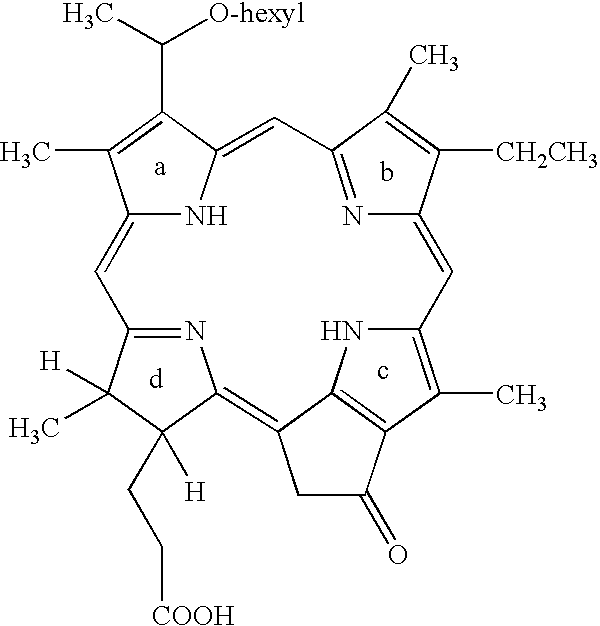Therapeutic hpph dosage for pdt
a hpph and pdt technology, applied in the direction of biocide, heterocyclic compound active ingredients, drug compositions, etc., can solve the problems of skin phototoxicity, normal tissue damage, insufficient penetration depth, etc., and achieve less normal tissue damage, less prolonged phototoxicity over time, and high tumor response
- Summary
- Abstract
- Description
- Claims
- Application Information
AI Technical Summary
Benefits of technology
Problems solved by technology
Method used
Image
Examples
Embodiment Construction
[0009]The HPPH is preferably injected as a part of a composition comprising 0.5 to 1.5 mg / ml HPPH, 0.05 to 0.15 wt. percent surfactant having a hydrophilic-lipophilic balance HLB of 14 to 16, 1 to 3 wt. percent ethanol and 3 to 8 wt. percent monosaccharide, preferably glucose, with the balance being water. Preferred surfactants are polysorbate 80 and sucrose ester, e.g. sucrose laurate or sucrose stearate.
[0010]For most applications, the preferred dose of HPPH is from 0.07 to 0.1 mg / kg of body weight and the preferred light dose is from 75 to 150 Joules / cm2
[0011]Table 1 gives results of a study of Photodynamic Therapy for the treatment of basal cell carcinoma using 2-(1-hexyloxyethyl)-2-devinyl pyropheophorbide-a (HPPH).
TABLE 1Results of treatment of basal cell carcinoma with HPPH at various conditionsTreatment EnergyAdverse50 J / cm2100 J / cm2150 J / cm2200 J / cm2150 J / cm2200 J / cm2EffectsDose@24 hr@24 hr@24 hr*@24 hr*@48 hr@48 hrNoted0.05 mg / kg*Complete10.05 mg / kg*Complete10.05 mg / kg*Co...
PUM
| Property | Measurement | Unit |
|---|---|---|
| surface area | aaaaa | aaaaa |
| weight | aaaaa | aaaaa |
| surface area | aaaaa | aaaaa |
Abstract
Description
Claims
Application Information
 Login to View More
Login to View More - R&D
- Intellectual Property
- Life Sciences
- Materials
- Tech Scout
- Unparalleled Data Quality
- Higher Quality Content
- 60% Fewer Hallucinations
Browse by: Latest US Patents, China's latest patents, Technical Efficacy Thesaurus, Application Domain, Technology Topic, Popular Technical Reports.
© 2025 PatSnap. All rights reserved.Legal|Privacy policy|Modern Slavery Act Transparency Statement|Sitemap|About US| Contact US: help@patsnap.com

